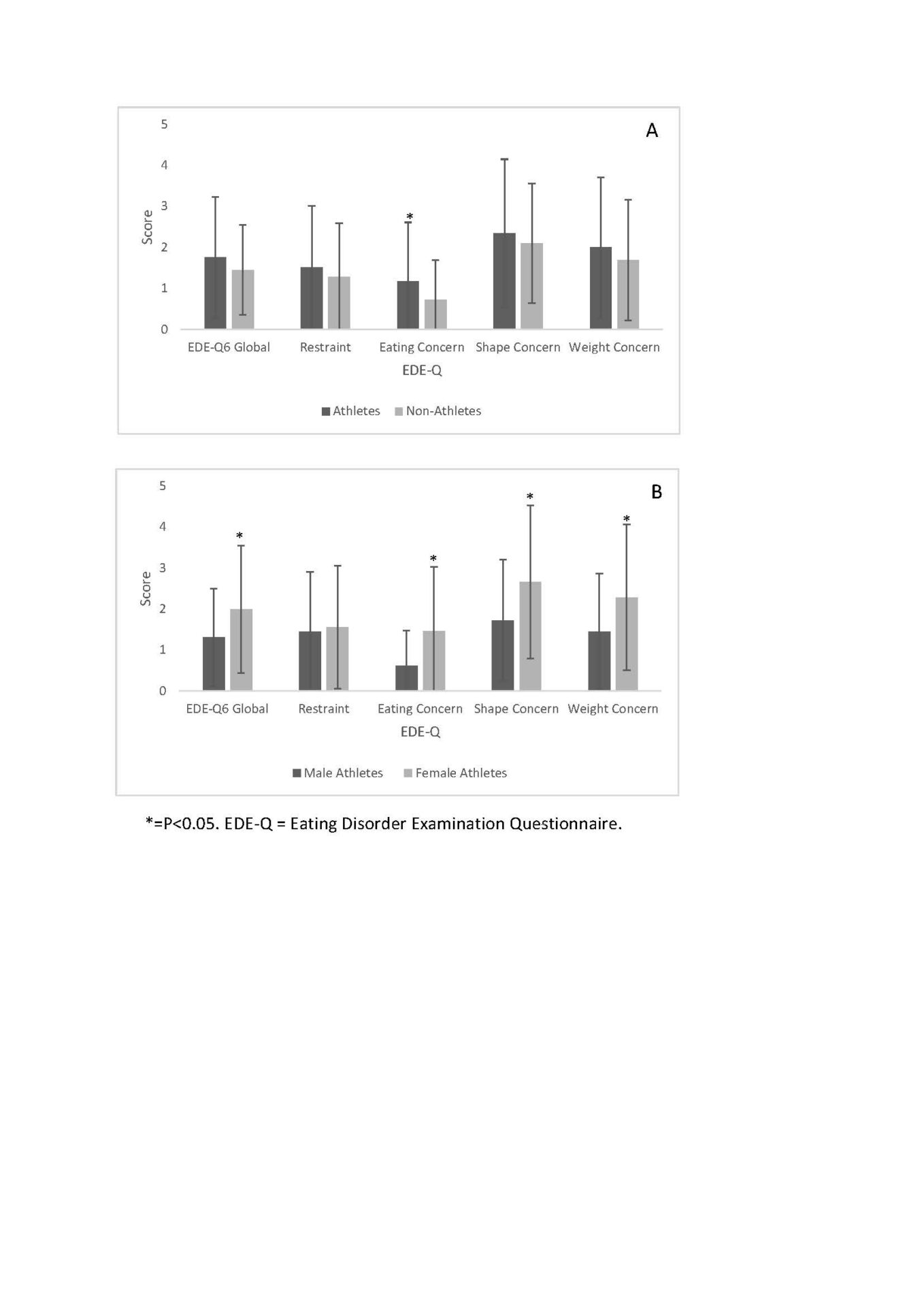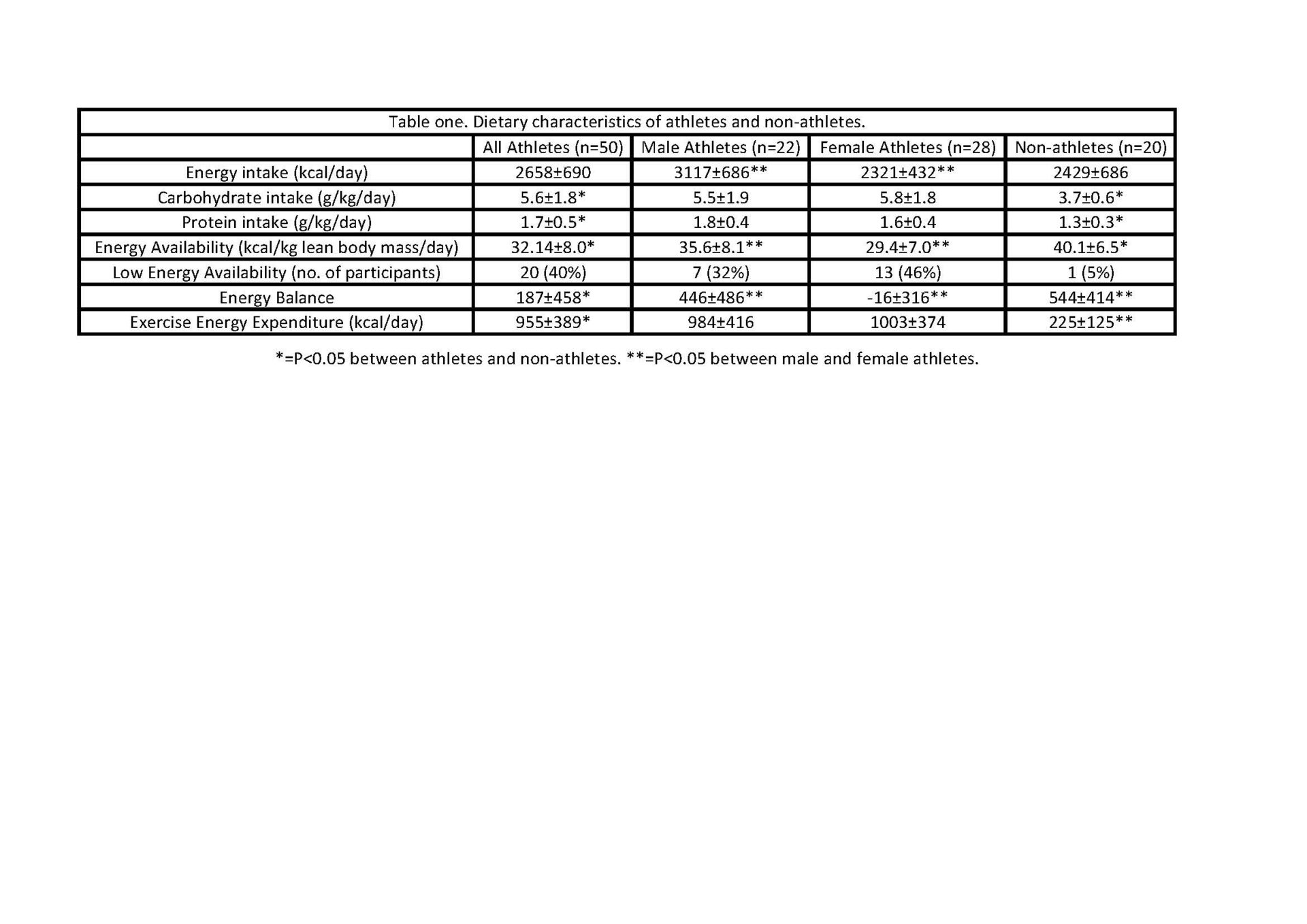Introduction: Many athletes fail to match energy intake (EI) to exercise energy expenditure (EEE) (Bratland-Sanda and Sundgot-Borgen, 2013). Consequently, athletes are at risk of low energy availability (LEA) and relative energy deficiency in sport (RED-S) (Areta et al., 2021). Endurance athletes are a high-risk population for LEA and RED-S due to high levels of EEE, increased prevalence of disordered eating (DE), and their desire to maintain a low body mass (Mountjoy et al., 2018). Previous literature has focused on elite-level or female athletes, and limited work has explored the relationship between the psycho-physiological manifestations of LEA and RED-S (Logue et al., 2020).
The purpose of the study was to assess a) the prevalence of DE, exercise dependency (EXD), depression, and LEA in non-elite competitive endurance athletes compared to non-athletes and b) to compare DE, EXD, mood disorders, and LEA prevalence in male athletes compared to female athletes.
Methods: One hundred and seventy-five participants were recruited, 44 male and 87 female endurance athletes and 44 non-athletes. All participants completed: Eating Disorders Examination Questionnaire 6 (EDE-Q 6.0), Profile of Mood State Questionnaire (POMS), ORTO-15, Exercise Dependence Scale-21 Manual (EXDS-21), Socio-cultural Attitudes Towards Appearance Questionnaire 4, Athletic Identity Measurement Scale (AIMS).
Seventy participants (50 athletes, 20 non-athletes) completed 4-day self-reported nutritional and exercise diaries. Twenty participants (ten athletes and ten non-athletes) undertook resting metabolic rate (RMR) measurements via indirect calorimetry and body composition and bone mineral density measurements via dual-energy X-ray absorptiometry.
Results: Athletes produced significantly greater scores for depression and all EXDS-21 measures and significantly lower ORTO-15 scores than non-athletes (P<0.05). Athletes had significantly greater scores for the eating concern subscale of the EDE-Q (P0.05) (figure one), and presented with a greater prevalence of pathologic DE and EXD behaviours than non-athletes (51% vs 8%).
Athletes presented with a 35% larger prevalence of LEA, significantly lower energy balance and energy availability, and significantly greater EEE, than non-athletes (P<0.05). 70% of athletes presented with RMR suppression, compared to 0% of non-athletes.
Female athletes demonstrated significantly higher scores than male athletes in the ‘eating concern', 'shape concern,' and 'weight concern' EDE-Q subscales (P<0.05) (figure one). Additionally, female athletes had a larger prevalence of LEA than male athletes (46% vs 32%) (table one).
Linear multiple regression analyses were conducted to calculate predictive factors of LEA, DE, and depression. Body mass, SATAQ-4 internalisation factors, and ORTO-15 and EXDS-21 scores significantly predicted EDE-Q score (F(5,44)=20.031, P<0.001, R2=0.70). Additionally, body mass and ORTO-15, EXDS-21, and EDE-Q scores were significant predictors of athletic EA (F4,45)=15.718, P<0.001, R2=0.58). Finally, body mass and EXDS-21 and EDE-Q scores significantly predicted depression (F(3,127)=41.496, P<0.01, R2=0.39).
Conclusions: Non-elite endurance athletes are at greater risk of DE, EXD, depression, and LEA than non-athletes, with female athletes at greater risk than male athletes. The reported prevalence of DE, EXD, and LEA matches studies in elite athletes. Future research should explore the relationships between the psycho-physiological manifestations of LEA to identify potential preventive treatment plans.
Biomedical Basis of Elite Performance 2022 (University of Nottingham, UK) (2022) Proc Physiol Soc 49, PC57
Poster Communications: Prevalence of disordered eating, exercise dependency, depression, and low energy availability in non-elite competitive endurance athletes compared to non-athletic individuals
Gregory Wright1, Maria Kotopoulea Nikolaidi1, Ifigeneia Giannopoulou1
1 University of Brighton
View other abstracts by:
Where applicable, experiments conform with Society ethical requirements.


